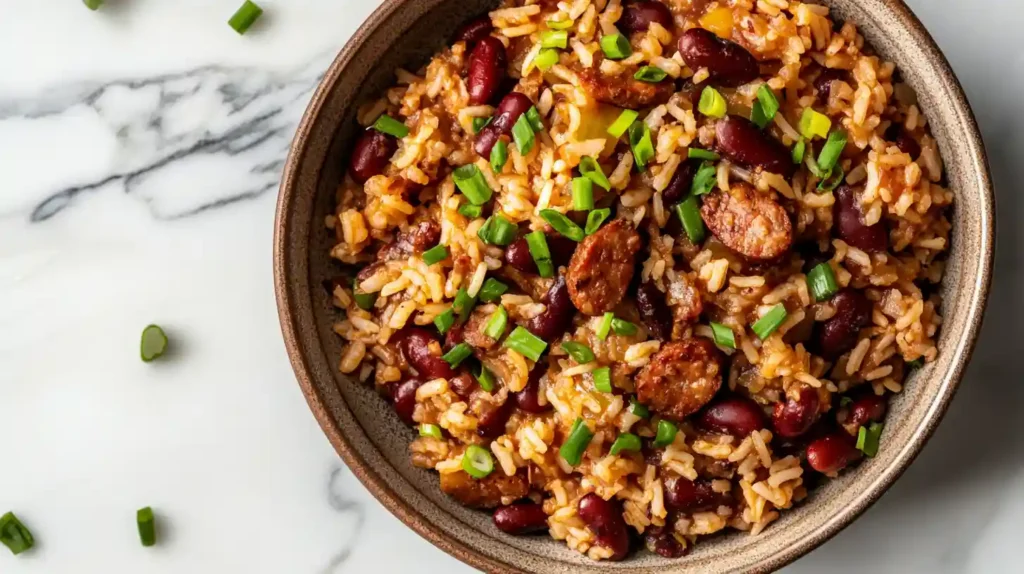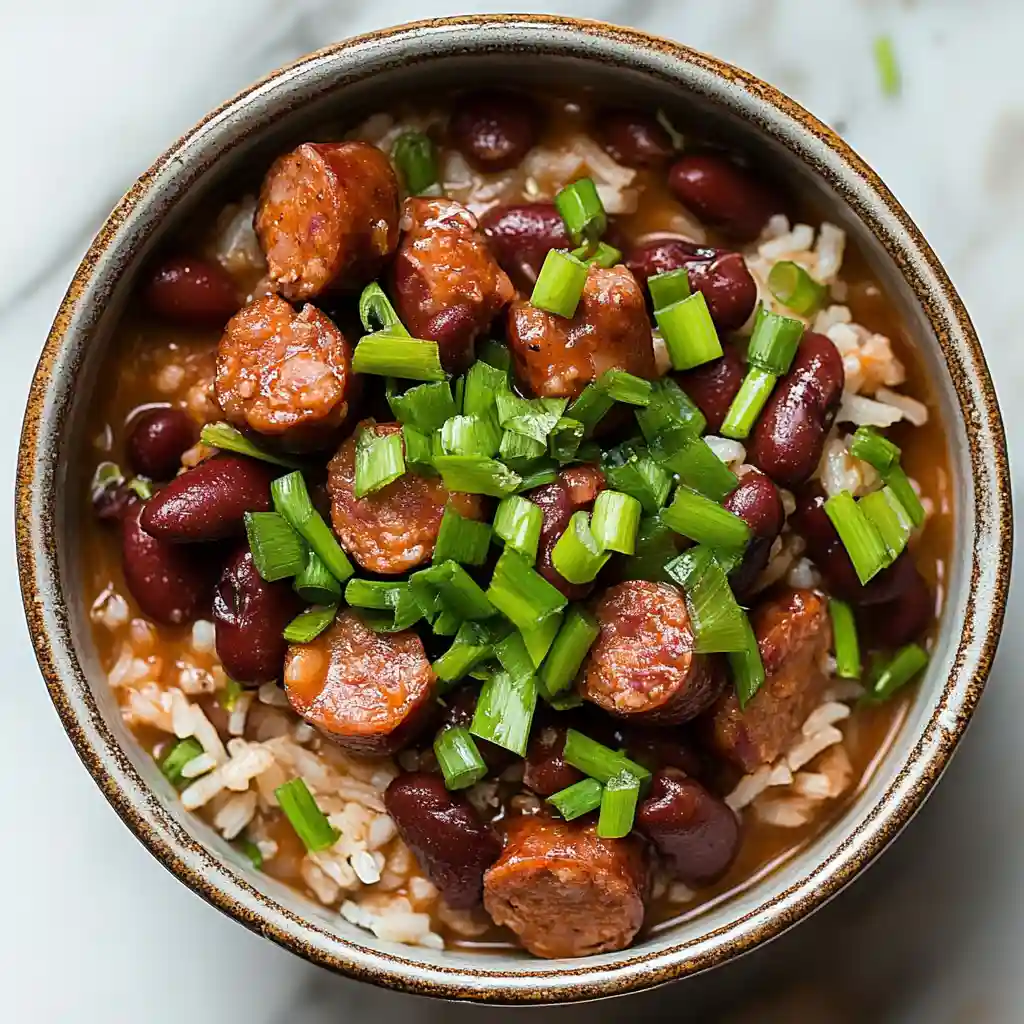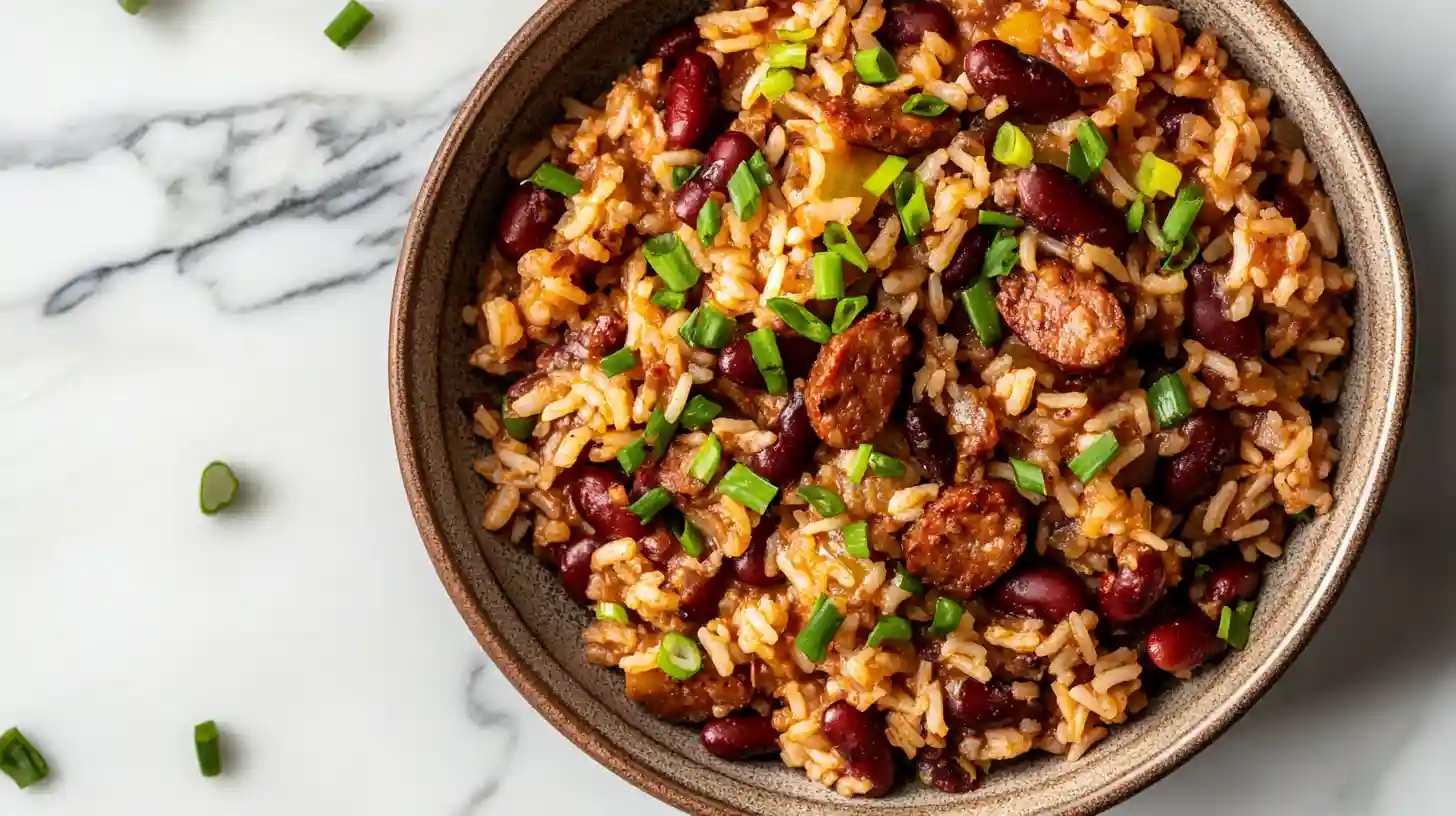Red beans and rice recipe is a tasty meal from the Southern United States, especially Louisiana. It has a long history connected to the cultures of that area. This dish is more than just food it represents community strength and cooking traditions.
What makes red beans and rice authentic? The blend of spices gives it flavor. The slow-cooked beans mixed with rice? This article will look at the elements creating the authenticity of red beans and rice, from preparation methods to key ingredients defining its character. We’ll share a proven recipe allowing you to make this beloved dish at home, capturing its essence. Whether an experienced cook or a beginner, this guide will help you understand how and why red beans and rice are so special.
Get ready to explore the world of red beans and rice, where each bite tells a story.

Table of contents
- The History of Red Beans and Rice: A Staple Dish in Southern Cuisine
- The Key Ingredients: Exploring the Role of Dark Red Kidney Beans
- The Authentic Flavors: How to Achieve the Perfect Balance of Spices
- Regional Variations: From Louisiana Creole to Caribbean Red Beans and Rice
- The Cultural Significance: Red Beans and Rice as a Symbol of Community and Tradition
- Tips for Cooking Perfect Red Beans and Rice: From Soaking to Simmering
- Serving Suggestions: Pairing Red Beans and Rice with Classic Southern Sides
- Conclusion
- FAQs
The History of Red Beans and Rice: A Staple Dish in Southern Cuisine
Red beans and rice are a classic dish that has deep roots in Southern cuisine, particularly in the states of Louisiana and Mississippi. This beloved dish is a staple in many households and is often associated with comfort food and communal gatherings. The combination of red beans and rice has a rich history and cultural significance, making it a cherished part of the culinary heritage of the region.
Red beans and rice have a long history that dates back to the early days of the American South. It is believed that the dish originated as a way for African slaves to make use of readily available ingredients such as red beans and rice, which were brought to the region by Spanish and French settlers. Over time, the dish evolved to incorporate local spices and seasonings, resulting in the flavorful and aromatic red beans and rice that we know today.
The dish became a mainstay in Southern cuisine due to its affordability, simplicity, and hearty nature. Red beans and rice were often prepared on Mondays, known as “wash day” in many Southern households, as it could be left to simmer on the stove while the women of the house tended to their laundry. This tradition of cooking red beans and rice on Mondays has persisted through the generations and remains a cherished part of Southern culinary culture.
The Key Ingredients: Exploring the Role of Dark Red Kidney Beans
The Flavor Base
In addition to dark red kidney beans, other essential ingredients include aromatics such as onions, bell peppers, and celery, which form the flavor base of the dish.
Adding Depth and Richness
Smoked meats such as ham hocks, Andouille sausage, or bacon are often used to add depth and richness to the dish.
A Complex Flavor Profile
The combination of these ingredients creates a complex and robust flavor profile that is synonymous with authentic red beans and rice.
The Authentic Flavors: How to Achieve the Perfect Balance of Spices

Achieving the perfect balance of spices is crucial to creating an authentic red beans and rice dish. A blend of spices such as thyme, bay leaves, cayenne pepper, and paprika adds depth and complexity to the flavor profile. The use of Creole seasoning, which typically includes a mix of herbs, spices, and salt, is also common in many traditional recipes.
The key to achieving authentic flavors lies in allowing the dish to simmer, allowing the spices to meld with the other ingredients and develop a rich, savory taste. This slow cooking process allows the flavors to intensify and creates a depth of flavor that is characteristic of well-prepared red beans and rice.
Regional Variations: From Louisiana Creole to Caribbean Red Beans and Rice
| Region | Main Ingredients | Spices | Serving Style |
|---|---|---|---|
| Louisiana Creole | Red beans, Andouille sausage, rice | Bay leaves, thyme, and cayenne pepper | Served over rice |
| Caribbean | Red kidney beans, coconut milk, rice | Scotch bonnet pepper, allspice, thyme | Served with rice and a side of plantains |
While red beans and rice are most commonly associated with Louisiana Creole cuisine, variations of the dish can be found throughout the Caribbean and other parts of the American South. In Louisiana, Creole red beans and rice often include a combination of Andouille sausage, ham hocks, and a blend of aromatic vegetables, resulting in a rich and smoky flavor profile. In Caribbean cuisine, red beans and rice may feature coconut milk, Scotch bonnet peppers, and additional spices such as allspice and nutmeg, giving the dish a unique tropical twist.
Despite these regional variations, the core elements of red beans and rice remain consistent, showcasing the adaptability of this beloved dish across different culinary traditions.
The Cultural Significance: Red Beans and Rice as a Symbol of Community and Tradition
Red beans and rice hold significant cultural importance in Southern communities, serving as a symbol of tradition, hospitality, and communal gathering. In many households, the act of preparing red beans and rice is a labor of love that brings families together around the dinner table. It is often served at social gatherings, church events, and community celebrations, where it fosters a sense of unity and connection among those who share in its enjoyment.
The dish’s association with Monday “wash day” traditions further underscores its role as a symbol of practicality and resourcefulness within Southern culture. Red beans and rice embody the spirit of making do with what is available while creating something nourishing and delicious—a testament to the resilience and ingenuity of Southern culinary traditions.
Tips for Cooking Perfect Red Beans and Rice: From Soaking to Simmering

Soaking for Even Cooking
Many traditional recipes call for soaking the red kidney beans overnight to ensure they cook evenly and achieve a creamy texture. This step also helps to reduce cooking time and improve digestibility.
The Art of Simmering
When it comes to simmering the dish, low and slow is the key. Allowing the flavors to meld over a gentle heat for an extended period results in a rich, flavorful sauce that coats each grain of rice.
The Reward of Patience
Patience is essential when cooking red beans and rice, as it rewards those who take the time to let the flavors develop fully.
Serving Suggestions: Pairing Red Beans and Rice with Classic Southern Sides
Red beans and rice are often served alongside classic Southern sides that complement its hearty flavors. Cornbread, collard greens, or fried okra are popular accompaniments that add texture and variety to the meal. A dollop of tangy coleslaw or a sprinkle of green onions can provide a refreshing contrast to the rich flavors of the dish.
For those seeking a complete meal, adding a portion of smoked or grilled meat, such as pork chops or fried chicken, can elevate the dining experience. The versatility of red beans and rice allows for endless pairing possibilities, making it a versatile centerpiece for any Southern-inspired feast. In conclusion, red beans and rice are more than just a dish; it is a symbol of tradition, community, and culinary ingenuity within Southern culture.
Its rich history, diverse regional variations, and cultural significance have solidified its place as a beloved staple in Southern cuisine. Whether enjoyed at home with family or shared at community gatherings, red beans and rice continue to bring people together through their comforting flavors and timeless appeal.
Conclusion
Red beans and rice are a hearty and satisfying comfort food. This classic Southern dish has deep roots in Louisiana cuisine. The rich cultural tapestry that makes Louisiana cuisine so special. Red beans and rice originated from Creole and Cajun cooking traditions. The dish symbolizes community, tradition, and resilience.
What makes it authentic? Is it the blend of spices that flavors the beans? Or the slow cooking process that allows the ingredients to blend harmoniously? Perhaps it’s the way families pass down their unique recipes over generations while preserving the dish’s essence.
This blog post explores these questions and provides a classic red beans and rice recipe capturing authenticity. Whether an experienced cook or a beginner, this recipe guides you in creating a delicious pot of red beans and rice, honoring its origins. Get ready to embark on a culinary journey celebrating one of Louisiana’s beloved dishes.
FAQs
1. What makes a red beans and rice recipe authentic?
Authenticity comes from a blend of traditional ingredients and methods: dark red kidney beans, aromatics like onions, bell peppers, and celery, smoked meats (such as Andouille sausage or ham hocks), and a well-balanced mix of Creole spices. Slow cooking is essential, as it allows the flavors to meld deeply and richly.
2. What is the history of red beans and rice as a staple dish in Southern cuisine?
The dish originated in Louisiana, rooted in African, Spanish, and French culinary influences. Historically, it was made on Mondays—“wash day”—because it could simmer unattended while chores were done. It became a symbol of resourcefulness, comfort, and family tradition, especially in African American communities.
3. What role do dark red kidney beans play in a red beans and rice recipe?
They are the star ingredient, providing a creamy texture and hearty base. These beans absorb the flavors of the meats and spices during slow cooking, creating a rich and satisfying dish. Soaking them ahead of time improves texture and reduces cooking time.
4. How can one achieve the perfect balance of spices for authentic red beans and rice flavors?
Use a combination of thyme, bay leaves, cayenne pepper, paprika, and Creole seasoning. Simmering the dish is key—it allows the spices to infuse fully and develop complexity. Patience during this process results in a deep, savory flavor profile.
5. What are some regional variations of red beans and rice, from Louisiana Creole to Caribbean styles?
- Louisiana Creole: Features Andouille sausage, smoked meats, and classic Creole spices like cayenne and thyme.
- Caribbean: Includes coconut milk, Scotch bonnet peppers, and allspice, giving it a tropical, spicy twist.
Both versions retain the core of beans and rice but reflect local flavors and ingredients.
6. What is the cultural significance of red beans and rice as a symbol of community and tradition?
It’s more than a meal—it’s a symbol of Southern hospitality, family, and resilience. Often served at community events, church dinners, or family gatherings, the dish fosters unity. Its historical role on “wash day” emphasizes practicality and care for loved ones.
7. What are some tips for cooking perfect red beans and rice, from soaking to simmering?
- Soak beans overnight to soften them and shorten cooking time.
- Simmer low and slow to develop depth and creaminess.
- Use smoked meats to infuse richness.
- Be patient—the longer it simmers, the better it tastes.
8. What are some serving suggestions for pairing red beans and rice with classic Southern sides?
Pair it with:
- Cornbread – for a sweet, crumbly contrast.
- Collard greens or fried okra – to add texture and earthy flavors.
- Coleslaw or green onions – for freshness and brightness.
- Smoked or fried meats – like pork chops or chicken, for a heartier meal.
- A Tasty Recipe You’ll Adore: Chicken Cauliflower Rice Casserole

Red Beans And Rice
Ingredients
Method
- In a large pot or Dutch oven, heat olive oil over medium heat. Add onion, bell pepper, and celery (the “holy trinity”) and sauté for 5–7 minutes until softened.
- Stir in garlic and sliced sausage. Cook for another 3–4 minutes until the sausage begins to brown.
- Add soaked and drained beans, ham hock, Creole seasoning, cayenne, thyme, bay leaves, and broth or water. Stir well.
- Bring to a boil, then reduce heat to low. Cover and simmer for 2–2½ hours, stirring occasionally, until beans are tender and creamy. If needed, mash some beans against the side of the pot to thicken.
- Remove bay leaves and ham hock. Taste and adjust seasoning. Serve hot over steamed white rice and garnish with green onions.
Notes
Calories: 460 kcal
Total Fat: 14g
Saturated Fat: 5g
Cholesterol: 40mg
Sodium: 850mg
Total Carbohydrates: 56g
Dietary Fiber: 11g
Sugars: 3g
Protein: 24g


